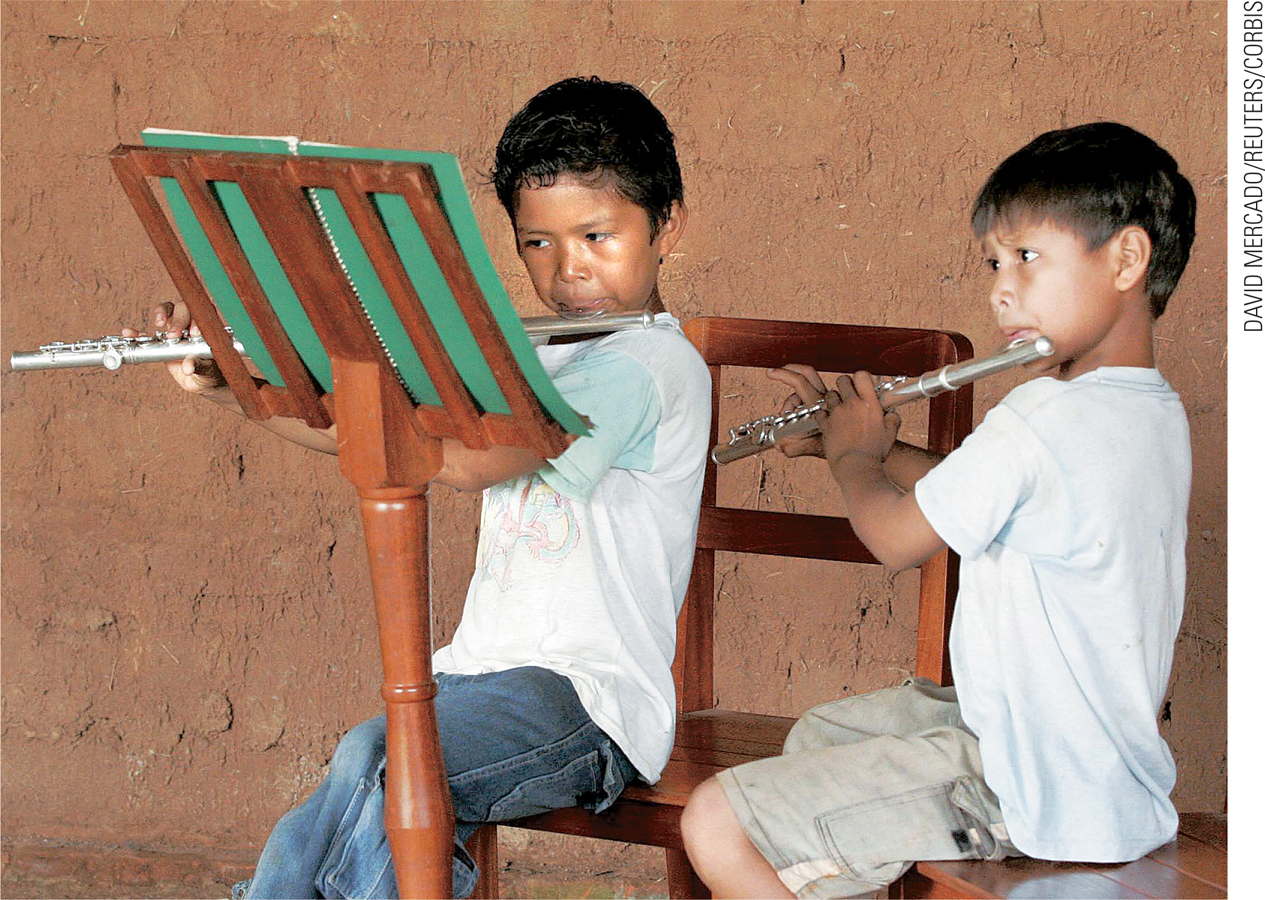A Healthy Time
Genes and environment safeguard middle childhood, as the years from about 6 to 11 are called (Konner, 2010). Fatal diseases and accidents are rare; both nature and nurture make these years the healthiest of the entire life span. In the United States in 2012, the death rate for 5-
The reasons are (1) genetic diseases are more threatening in early infancy or old age than in middle childhood, (2) infectious diseases are kept away via immunization, and (3) fatal accidents—
The already low death rate has been further reduced recently. For example, in the United States in 1950, the death rate per 100,000 children aged 5 to 14 was 60; in 2010, it was 13. Even the incidence of minor illnesses, such as ear infections, infected tonsils, and flu, has been reduced, in part because of better medicine and immunization (National Center for Health Statistics, 2013).
Slower Growth, Greater Strength
Unlike infants or adolescents, school-
Teeth
Important to the individual child is the loss of baby teeth, with the entire set replaced by permanent teeth beginning at about age 6 (with girls a few months ahead of boys) and complete by puberty.
Important to society is oral health overall. Worldwide sixty years ago, many children neither brushed their teeth nor saw a dentist, and fluoride was almost never added to water. That’s why many of the oldest-
Currently, most school-
Children’s Health Habits
Good childhood habits protect later adult health. The health that most school-
349
Children’s habits during these years are strongly affected by peers and parents. When children see others routinely care for their health, social learning pushes them to do the same. Camps for children with asthma, cancer, diabetes, sickle cell anemia, and other chronic illnesses are particularly beneficial because the example of other children and the guidance of knowledgeable adults help children learn self-
Physical Activity

Beyond the sheer fun of playing, the benefits of physical activity—
How could body movement improve brain functioning? A review of the research suggests several possible mechanisms, including direct benefits of better cerebral blood flow and increased neurotransmitters, as well as the indirect results of better mood (Singh et al., 2012).
A new concept in psychology is embodied cognition, that human thoughts are affected by body health, comfort, position and so on. If this is true, then a well-
Neighborhood Games
Neighborhood play is flexible. Rules and boundaries are adapted to the context (out of bounds is “past the tree” or “behind the parked truck”). Stickball, touch football, tag, hide-
Children play tag, hide and seek, or pickup basketball. They compete with one another but always according to rules, and rules that they enforce themselves without recourse to an impartial judge. The penalty for not playing by the rules is not playing, that is, social exclusion.
[Gillespie, 2010, p. 298]

For school-
Unfortunately, modern life has undercut informal neighborhood games. Vacant lots and empty fields have largely disappeared, and parents fear “stranger danger”—thinking that a stranger will somehow hurt their child (which is exceedingly rare) and ignoring the many benefits of outside play, which are universal. As one advocate of more unsupervised, creative childhood play sadly notes:
Actions that would have been considered paranoid in the ’70s—
[Rosin, 2014]
350
Indoor activities such as homework, television, and video games crowd out outdoor play, partly because parents always want to see where their children are and what they are doing.
Many parents enroll their children in organizations that offer—
Exercise in School
When opportunities for neighborhood play are scarce, physical education in school is a logical alternative. However, because schools are pressured to focus on test scores in academic subjects, time for physical education and recess has declined. A study of Texas elementary schools found that 24 percent had no recess at all and only 1 percent had recess several times a day (W. Zhu et al., 2010).

Texas, unfortunately, is no exception. A survey asking teachers of more than 10,000 third-
These researchers write that “many children from disadvantaged backgrounds are not free to roam their neighborhoods or even their own yards unless they are accompanied by adults. For many of these children, recess periods may be the only opportunity for them to practice their social skills with other children” (Barros et al., 2009, p. 434). Thus, school exercise is least likely for children who most need it—

Even when gym is required, classes may be too crowded to allow extensive active play, or the school may implement gym on paper but not in practice. For instance, although Alabama requires elementary schools to have daily physical education for at least 30 minutes, a study of all primary schools in one district found that only 22 minutes a day was actually devoted to gym. None of the schools had recess or after-
Several organizations have developed guidelines to prevent concussions among 7-
351
Ironically, schools in Japan, where many children score well on international tests, usually have several recess breaks totaling more than an hour each day. Japanese public schools typically have good equipment for physical activity, including an indoor gym and a pool.
Especially for Physical Education Teachers A group of parents of fourth-
Discuss with the parents their reasons for wanting the team. Children need physical activity, but some aspects of competitive sports are better suited to adults than to children.
SUMMING UP School-
WHAT HAVE YOU LEARNED?
Question 11.1
FC4wy8DNrjOHi3ecbL8rz0ssI0StdNSWiM3iELK8peCB9NXwHqsI27PIh50Rmfz6a2JPVL3sPv0=Motor skills become refined and hand–eye coordination improves, making sports, self– care, and other physical activities possible and easy for this age group. Question 11.2
1qZWdNDwKPNzP4zISN5d62Q5zOnUxNf5+asvf7qa7SmmcxTpmZBEHEWyPwUw8Ca9Uf8hQZW9nNM=Failure to develop good health habits in childhood may result in an adult who does not take the steps necessary to protect his or her own health.Question 11.3
SrnvJFRTQjjzki1X+4MIMxJYdU2raXIPilIPum7HllBIRemb67bBgveLLj3bP+Bal3LXwmYfvrL8DP3bd4dkd5KRJ57AhhRpZcAUeuBbQHjM4dvGWiZz0VVZ8Tg=The benefits include better overall health, less obesity, appreciation of cooperation and fair play, improved problem–solving abilities, and respect for teammates and opponents of many ethnicities and nationalities. Hazards include loss of self– esteem if performance is poor, possible injuries, reinforcement of prejudices, and increased stress. Question 11.4
zbs9DH8qB6zs1/6sytq2kqRBRQqwwO6YZ7N8g871+8C+4KV4XOj7yeYNeI6rLVzmHn3hP2qBSobzCvHsP2fJEw==For children who do not have the opportunity to play in the neighborhood, physical education can be a good substitute. Recess gives children a chance to practice social skills with other children. Exercise can actually improve academic performance by improving blood flow to the brain, boosting neurotransmitters, and expending excess energy so children can cognitively focus.